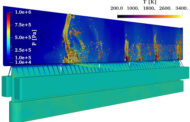
NASA has achieved a new benchmark in developing an innovative propulsion system called the Rotating Detonation Rocket Engine (RDRE). Engineers at NASA’s Marshall Space Flight Center in Huntsville, Alabama, successfully tested a novel, 3D-printed RDRE for 251 seconds (or longer than four minutes), producing more than 5,800 pounds of thrust.
That kind of sustained burn emulates typical requirements for a lander touchdown or a deep-space burn that could set a spacecraft on course from the Moon to Mars, said Marshall combustion devices engineer Thomas Teasley, who leads the RDRE test effort at the center.
RDRE’s first hot fire test was performed at Marshall in the summer of 2022 in partnership with In Space LLC and Purdue University, both of Lafayette, Indiana. That test produced more than 4,000 pounds of thrust for nearly a minute. The primary goal of the latest test, Teasley noted, is to better understand how to scale the combustor to different thrust classes, supporting engine systems of all types and maximizing the variety of missions it could serve, from landers to upper stage engines to supersonic retropropulsion, a deceleration technique that could land larger payloads – or even humans – on the surface of Mars.
Test stand video captured at NASA’s Marshall Space Flight Center in Huntsville, Alabama, shows ignition of a full-scale Rotating Detonation Rocket Engine combustor, which was fired for a record 251 seconds and achieved more than 5,800 pounds of thrust.
“The RDRE enables a huge leap in design efficiency,” he said. “It demonstrates we are closer to making lightweight propulsion systems that will allow us to send more mass and payload further into deep space, a critical component to NASA’s Moon to Mars vision.”
Engineers at NASA’s Glenn Research Center in Cleveland and researchers at Venus Aerospace of Houston, Texas, are working with NASA Marshall to identify how to scale the technology for higher performance.
Original Article: NASA’s 3D-printed Rotating Detonation Rocket Engine Test a Success
More from: NASA | Purdue University
The Latest Updates from Bing News
Go deeper with Bing News on:
Rotating Detonation Rocket Engine
- Superfast drone fitted with new 'rotating detonation rocket engine' approaches the speed of sound
The experimental fusion reactor sustained temperatures of 180 million degrees Fahrenheit for a record-breaking 48 seconds.
- World's fastest camera captures footage at 156 trillion frames per second
This camera can generate clips of breathtakingly quick processes — and could help scientists create ultrafast magnetic memory and pioneering ultrasonic medical treatments.
- This insanely fast rocket-powered drone can almost reach Mach 1
Engineers have successfully flown a superfast drone that can reach close to Mach 1, which is the speed of sound. The drone is able to reach these milestones thanks to a new “rotating detonation rocket ...
- Bid to create 6,900mph passenger jet with new 'rocket engine'
The company hopes to use this type of engine to build commercial Mach 9 speed planes in the future. Mach 9 is nine times the speed of sound which is over 6,900 miles power. A plane traveling that fast ...
Go deeper with Bing News on:
RDRE
- Superfast drone fitted with new 'rotating detonation rocket engine' approaches the speed of sound
The experimental fusion reactor sustained temperatures of 180 million degrees Fahrenheit for a record-breaking 48 seconds.
- This insanely fast rocket-powered drone can almost reach Mach 1
Engineers have successfully flown a superfast drone that can reach close to Mach 1, which is the speed of sound. The drone is able to reach these milestones thanks to a new “rotating detonation rocket ...
- Venus Aerospace Achieves Successful Inaugural Supersonic Drone Flight
The test successfully demonstrated flight controls, stability, one leg of the ultimate Rotating Detonation Rocket Engine (RDRE) propulsion system, telemetry, ground operations, and air launch.
- Video: Supersonic drone flies with revolutionary detonation engine
When Venus Aerospace's aircraft does go supersonic on a later date, it will be powered by a Rotating Detonation Rocket Engine (RDRE). Supersonic drones may sound like something bleeding edge ...
- Watch: This Bonkers Supersonic Drone Almost Hit the Speed of Sound on a Test Flight
The production model will be equipped with a revolutionary Rotating Detonation Rocket Engine (RDRE), though. The robotic aircraft was dropped at an altitude of 12,000 feet and accelerated to a top ...







